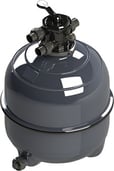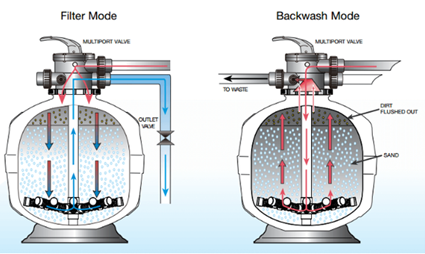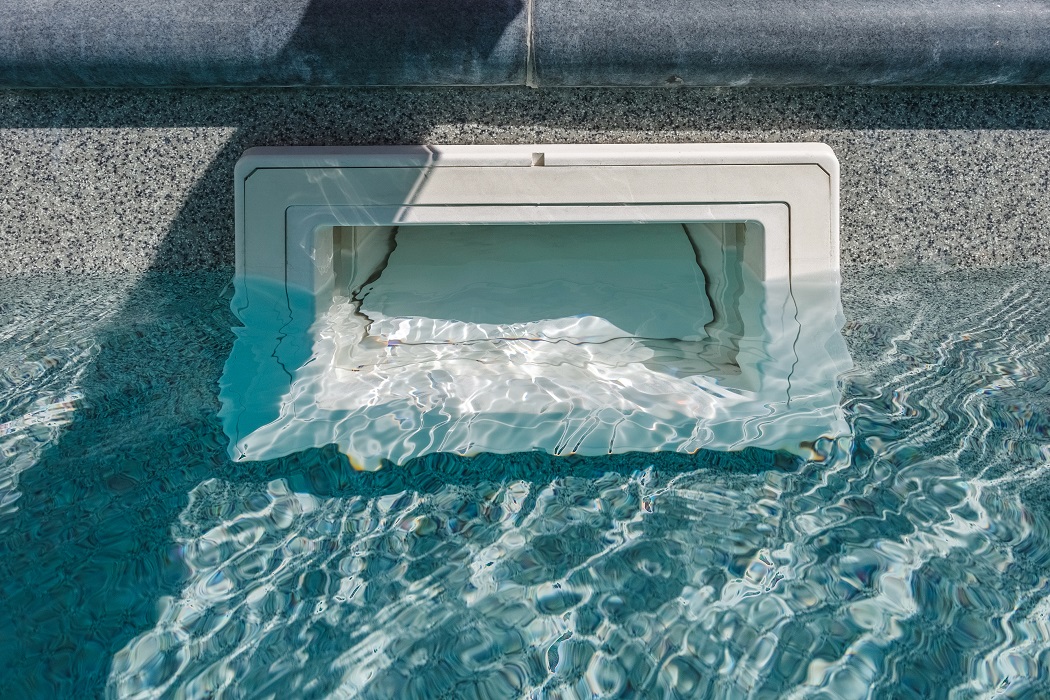Cartridge versus Media Pool Filters - Which Is Best?
All pools need filters, including DIY pools. Pool filters remove the big organic stuff and the microscopic particles in your water which bacteria and algae spores like to feed on. Getting the right filter will mean the difference between safe, low maintenance, sparkling clear water or being on a first name basis with your local pool chemical shop constantly trying to fix water quality problems.
How do pool filters work? Your pool pump draws water from your swimming pool through the skimmer box and into your pool filter. This water is forced through either sand, glass or a mesh cartridge element which traps the unwanted particles. Clean water is pumped back into your swimming pool through the return jets (sometimes called “eyeballs”) that are usually found in the shallow end of your pool.
It is super important to match your filter litres per minute (LPM) flow rate to your pump LPM flow rate. If your pump flow rate is too high for your filter (think trying to drink water from a fire hose), your filter will be in a for hard time, a short life and your water quality will be affected. If your pump flow rate is too low for your filter, there will not be enough pressure to force your pool water through the filter for it to do its job properly. Both mismatches will result in underperforming filtration which will cost you plenty in time, chemicals and frustration trying to keep your pool water safe and clear.
So, what type of filters are there and what are the pro's and con's? Great question!
Media Pool Filters
Unfortunately, we are not referring to a new app that filters out unwanted media ads on your smart phone. "Media" refers to what you choose to fill your filter with – either sand or glass. 
– Sand Media
20 grade silica sand has been used for decades, hence the older term “sand filters”. Under a microscope, each particle of sand has jagged edges. It is these edges that capture the tiny particles in your water. Over about 5 years these edges are worn smooth, losing their filtering ability, and need to be replaced. Replacing the sand is a job most pool owners do themselves and it isn't a big job. A mid-sized sand filter will hold around 120kg of sand which costs $140 to replace. At an average of $28 per year over 5 years, it is very cost effective.
– Glass Media
You can also use crushed recycled glass (glass media) rather than sand. Why? The glass particles are smaller and harder than sand so they capture the smaller particles (down to 5 micron - a human hair is 70 micron) that would be missed by sand media. It takes around 7 years for glass to be worn smooth and needing to be replaced. 120kg of glass media will cost around $240. At an average of $34 per year, it will not break the bank. While it is more expensive than sand initially, over 7 years (compared to 5 years for sand), the costs are very similar. If you are expecting your pool to be continually full of kids (called high bather load), glass will do a better job of keeping your water crystal clear compared to sand. If you are thinking of mineralising your pool, glass media is recommended by most manufacturers as the magnesium in the minerals acts as a flocculant. A what? Flocculants binds very small particles together to form a particle large enough to be removed by your filter. As glass removes smaller particles than sand, your water tends to look clearer and more sparkly.
Don’t media pool filters waste a lot of water? To maintain a media filter, the media needs to be cleaned every month on average in summer (or when the pressure gauge needle on your filter is pointing to red) by backwashing and rinsing. This is as easy as turning the handle on top of your filter to "backwash" and turning on your pump. Backwashing reverses the water flow direction through your filter which stirs up the media (it is like shaking a snow cone) releasing the dirt and particles. The dirty water is usually discharged into your sewer line, soak wells or away from your pool. A backwash is simple to do and only takes a couple of minutes. The handle is then turned to "rinse" to settle the media back into place before being returned to the normal daily filter mode setting.

It takes longer for sand media to be flushed clean by backwashing than glass. On average, each sand media backwash will use around 300 litres of water. Glass media is lighter than sand which makes backwashing more efficient and reduces the amount of water used to around 180 litres.
Media pool filters generally cost between $700 and $1,200 with top end models up to $2,100. It is important to check what the outer shell is made from. If your pool filter will be exposed to the sun, lean towards a fibreglass shell over injection mould plastic. Fibreglass is much more durable in the elements and will last a lot longer than plastic under the harsh Australian sun. They cost more than injection mould plastic so a trip to Bunnings for materials to knock up a quick overhead cover might be cheaper.
Cartridge Pool Filters
If space for your pump, filter and chlorinator is tight, a cartridge filter has a much smaller footprint than a media filter. Inside a cartridge pool filter is a filter element that is usually several layers of fine mesh (like flyscreens however with much smaller holes). This mesh filters out the same size particles as glass media filters and works much the same way. Water is pushed through the mesh under pressure which traps the particles in your water.
much smaller footprint than a media filter. Inside a cartridge pool filter is a filter element that is usually several layers of fine mesh (like flyscreens however with much smaller holes). This mesh filters out the same size particles as glass media filters and works much the same way. Water is pushed through the mesh under pressure which traps the particles in your water.
Cartridge filters don't hold as much dirt and particles as a media filter and need to be cleaned more frequently. Where a media filter might need cleaning every 4 or 5 weeks, a cartridge filter might need cleaning every 2 or 3 weeks. The top of the filter has a pressure gauge which lets you know when the element is full and no longer filtering effectively.
Cleaning is a bit more messy and time-consuming than media filters however still easy enough. The filter element is lifted out by unscrewing the top of the filter. Most pool owners use a garden hose with a fine spray setting to wash the elements. It will usually take 5 to 10 minutes. Best practice is to give the element an overnight soak in a cleaning solution to kill bacteria and other critters in the mesh. We recommend having two cartridges so your pump and filter can run while one cartridge is cleaned and soaked overnight.
Cleaning the filter element will use between 50 and 80 litres of water on average which is less than media filters use. However, if you are cleaning your filter element every 3 weeks, compared to a glass media filter you will use roughly the same amount of water over a year.
Cartridge filters cost an average between $500 and $1,100, with top end models up to $2,200. Replacement filters cost between $100 and $300. If regularly cleaned, the element needs to be replaced every 2 years on average. Without regular cleaning, you might need to replace them annually. Assuming replacement every 2 years at a cost of $150, over 6 years you will spend $450 which makes cartridge filters similar in cost to media filters over the same period.
Key Takeaway – Cartridge filters have been popular inclusions by major pool companies over the last 10 years as they are cheaper than media filters and take up less warehouse space to store. Both cartridge and media filters are very effective at filtering your pool to a similar level of water quality. Your decision is going to come down to the amount of space you have, ability and willingness to discharge dirty water (media filter) and how much time you want to spend maintaining your pool each month. It also comes down to how much your pool is being used.
If your pool is high use (two or three kids in the pools most days during the swimming season), you'll be cleaning your filter a lot more often than your neighbour who has a dip every week or so. A cartridge filter might be more time-consuming than you prefer if your pool is high-use.
If you want the lowest cleaning frequency and time for each clean, a media filter will keep a smile on your dial with high use pools. If your pool is low use, the filter will need cleaning infrequently, so a cartridge filter will fit the bill as well as a media filter.
If your filter and pump flow rates are mismatched or you filter is not being kept clean, you will have water quality problems whether you have a media filter or cartridge filter!
Related Blogs
Installing a pool is a big deal—it’s not just about cooling off on a scorching summer’s day; it’s about creating that ultimate backyard escape where friends and family can make memories for years to....
There’s nothing like stepping into your DIY plunge pool after a long day. You installed it, you love it, and it’s your little slice of paradise. Just like your lawn, your pool isn’t set and forget -....
If your heat pump is running and you’re noticing water at the bottom of the unit or around the unit that you haven’t noticed previously, it is easy to think the worst and assume that your heat pump....
About The Author
My wife and I grew up playing in swimming pools. Our daughters learnt to swim in our backyard fibreglass swimming pool. There is nothing quite like hearing kids splashing about and giggling. As pools do, our pool became a social magnet for friends, family and neighbours which we loved. Helping customers to have their own pool and saving customers thousands on their pool and equipment is the best job in the world.
























